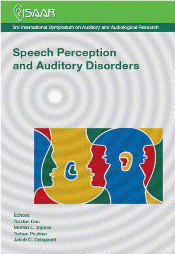Comparing hearing-aid algorithm performance using Simulated Performance Intensity Functions
Abstract
Simulated performance-intensity functions were used to quantitatively discriminate speech intelligibility through phoneme discrimination assessment. Listener test results for subjects with a wide range of sensorineural hearing losses were simulated using an auditory nerve model and compared to real listeners' unaided and aided performance. Simulations of NAL-RP and DSL 4.0 fitting algorithms were compared. Auditory-nerve discharge patterns from the model were presented as neurograms. An automated ranking process was used to quantify neurogram degradation using a new measure, the Neurogram Similarity Index Measure (NSIM). The measure has previously been shown to correlate well in predictions of phoneme discrimination for normal hearing listeners in both quiet and noise. In this study, simulated responses to consonant-vowel-consonant word lists in a quiet environment at a range of presentation levels were used to produce phoneme discrimination scores. This represents a further step in validating the use of auditory-nerve models to predict speech intelligibility for different hearing-aid fitting methods in a simulated environment, allowing the potential for rapid prototyping and early design assessment of new hearing-aid algorithms.
References
Boothroyd, A. (1968). "Developments in Speech Audiometry" Sound 2 (1): 3 - 10.
Boothroyd, A. (2006). Computer-Aided Speech Perception Assessment (CASPA) 5.0 Software Manual. San Diego, CA. San Diego, CA.
Boothroyd, A. (2008). "The Performance/Intensity Function: An Underused Resource" Ear and Hearing 29 (4), 479-491.
Bruce, I. C., F. Dinath, et al. (2007). Insights into optimal phonemic compression from a computational model of the auditory periphery. Auditory Signal Processing in Hearing-Impaired Listeners, Int. Symposium on Audiological and Auditory Research (ISAAR). eds T. Dau, J. Buchholz, J. M. Harte and T. U. Christiansen. Danavox Jubilee Foundation Denmark: 73-81.
Ching, T. Y. C., H. Dillon, et al. (2010). "Evaluation of the NAL-NL1 and the DSL v.4.1 prescriptions for children: Paired-comparison intelligibility judgments and functional performance ratings" International Journal of Audiology 49 (S1).
Dillon, H. (2001). Hearing Aids. Thieme Medical Publishers, New York.
Hines, A. and N. Harte (2010). "Speech Intelligibility from Image Processing" Speech Communication 52 (9), 736-752.
Hines, A. and N. Harte (2011). "Speech Intelligibility prediction using a Neurogram Similarity Index Measure" Speech Communication, [doi:10.1016/j.specom.2011.09.004].
Kates, J. M. and K. H. Arehart (2010). "The Hearing-Aid Speech Quality Index (HASQI)" J. Audio Eng. Soc 58 (5), 363-381.
Zilany, M. S. A., I. C. Bruce, et al. (2009). "A phenomenological model of the synapse between the inner hair cell and auditory nerve: Long-term adaptation with power-law dynamics" J. Acoust. Soc. Am. 126 (5), 2390-2412.
Additional Files
Published
How to Cite
Issue
Section
License
Authors who publish with this journal agree to the following terms:
a. Authors retain copyright* and grant the journal right of first publication with the work simultaneously licensed under a Creative Commons Attribution License that allows others to share the work with an acknowledgement of the work's authorship and initial publication in this journal.
b. Authors are able to enter into separate, additional contractual arrangements for the non-exclusive distribution of the journal's published version of the work (e.g., post it to an institutional repository or publish it in a book), with an acknowledgement of its initial publication in this journal.
c. Authors are permitted and encouraged to post their work online (e.g., in institutional repositories or on their website) prior to and during the submission process, as it can lead to productive exchanges, as well as earlier and greater citation of published work (See The Effect of Open Access).
*From the 2017 issue onward. The Danavox Jubilee Foundation owns the copyright of all articles published in the 1969-2015 issues. However, authors are still allowed to share the work with an acknowledgement of the work's authorship and initial publication in this journal.


